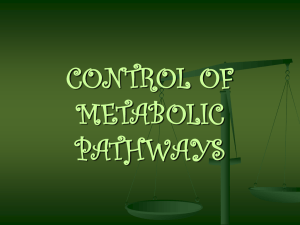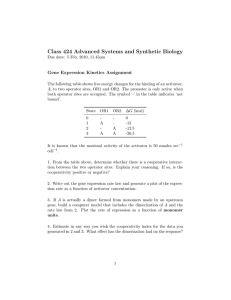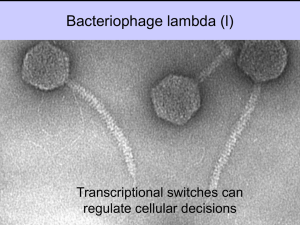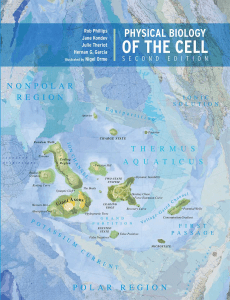The Saga terminator: continues
advertisement
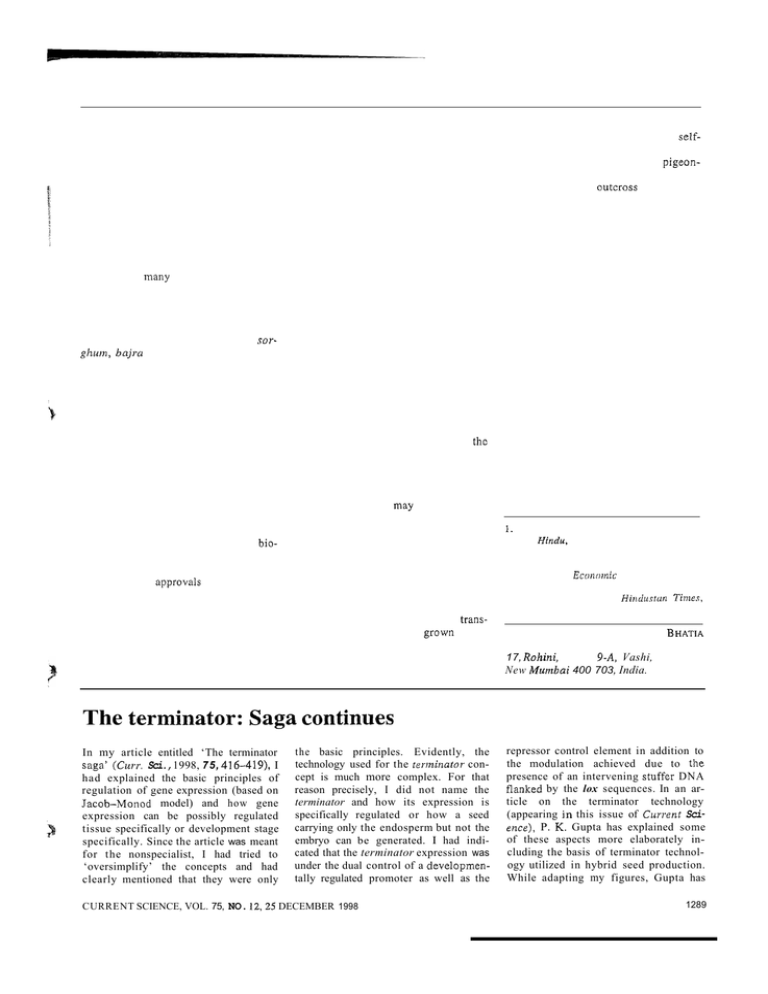
self- outcross inany sorghziin, bnjra tlic may 1. Hindu, Ecoiinmic trans- grown 17, New %A, Vashi, 400 703, India. The terminator: Saga continues In my article entitled ‘The terminator saga’ ( C w r . Sci., 1998, 75, 416-419), I had explained the basic principles of regulation of gene expression (based on Jacob-Monod model) and how gene expression can be possibly regulated tissue specifically or development stage specifically. Since the article was meant for the nonspecialist, I had tried to ‘oversimplify’ the concepts and had clearly mentioned that they were only the basic principles. Evidently, the technology used for the teriniriator concept is much more complex. For that reason precisely, I did not name the terminator and how its expression is specifically regulated or how a seed carrying only the endosperm but not the embryo can be generated. I had indicated that the terminator expression was under the dual control of a developrnentally regulated promoter as well as the CURRENT SCIENCE, VOL. 75, NO. 12,25 DECEMBER 1998 repressor control element in addition to the modulation achieved due to the presence of an intervening stuffer DNA ilanked by the lox sequences. In an article on the terminator technology (appearing in this issue of Current Science), P. K. Gupta has explained some of these aspects more elaborately including the basis of terminator technology utilized in hybrid seed production. While adapting my figures, Gupta has 1289 -si __ I 1 CORRESPONDENCE c l ~ r i f i ~that d the terminator itself was these systems, the genomic DNA is Ornot under the operatorlrepressor control ganized as chromatin (bound to several 1 but only developmentally regulated) proteins) and therefore, it stays gener~~~~r~~~ reromhinase was the one that ally in a repressed state. The expression of a gene takes place only consequent to was ~ ~ ~ ~ by t rthe ~ operatorlrepressor ~ l l ~ d rystern. He may well be right but my activation. Obviously, the ‘catch’ is to i n ~ ~ ~ were: ~ ~ o (i) n s to overemphasize get the activators to the promoter site the regulation of terminoror expression where the transcription process initiates. hy invoking the multiple mechanisms, This is generally achieved by providing siz. ~ p ~ r a t o r ~ r ~ p r emediated ~ s o r inter- appropriate binding sites for the activa~ ~ as well ~ asi developmental ~ ~ n regula- tor on the DNA close to the promoter. tim together with the crellon In fact one can convert a ‘repressor’ into an ‘activator’ by ‘fusing’ the acti~ e ~ ~ and n (ii) ~ ~to ~establish ~ y that , ofe a eukaryotic transcrip~ ~expression ~ of the r gene can ~ be ~vator domain ~ ~ achieved by providing tandem re- tion activator (classic example, the activator ~ r ~ ~ sites~ close ~ to rthe pro~ ~ HSV-VP16 ~ ~ d i ~domain ~ fused to fbecausein this case the repressor specific DNA binding domain). Such a was converted to function as an activa- fused molecule will now function as an tor). Therefore, at this point it may be activator rather than a repressor for a ~ ~ ta provide ~ further ~ clarificar ~ given~gene, if~the repressor e binding sites ttms to the more specialized readers are provided in cis to the promoter. ~~~~~~~~n~ the mnlccular mechanisms of Thus, for in~tancel-~, if the ‘operator’ ~ ~utilized ~ in the ~ plantt cell. r ~ element ~ of the tetracyclin resistance irsf of all, the ‘oversimplified’ operon (originally derived from the [hiit I had presented was based on bacterial transposon, TnlO) is located in ~~r~~~~~ systems (bacteria) where proximity to the promoter of a gene, its ‘repressor’ protein binding to expression can be turned on by providthe C ~ lck~us ~ ’operator’ ~ ~provides r a ~ ing~ the fused tetracyclin repressorI S C ~to the transcription machin- VP16 activator protein in lrans. Once erj and prevents the expression of the tetracyclin is added to this system, the Such simple mechanisms are not repressor-VP16 protein falls off the lhet OneS nperative in euknryotic operator locus and the transcription ~~r~~~~~~~ t h t h p h t s and animals). In switches off. Further sophistication of this control can b e achieved by converting the tetracyclin repressor (by mutations) such that it binds lo t h e operator only in the presence of the antibiotic, I behaviour diametrically opposite to that of the parental molccule. I n this case, only on addition of tetracyclin docs h e repressor-VPIG bind to the cis clcnlcttt and activate transcription from the target gene (see references for detnifs),As mentioned previously, the actual methodology for controlling the exprcssicm of the terminator i n the plant cells therefore, is likely to be more co1nplcx than the oversimplified version prcsented earlier. ~~~~~ I . Gossen, M. and Rujard, Proc. NrrrL Acad. Sci. USA, 1992, 89, SS47-5551. 2. Gossen, M., Freundlieb, S . , Bunder, G., Mullcr, G.,Hillen, W. :ind I3iijarcL li., Science, 1995, 268, 1766-1 760. 3. Yin. D. X . , Zhu, L. ant1 Schilukc, It. Anal. Biochena., 1996, 235, 195-201. ’r., ~~~~ Microbiology and Cell Biology Department, Indian Institute of Scimce, Bangalore 560 012, Irzcliu

